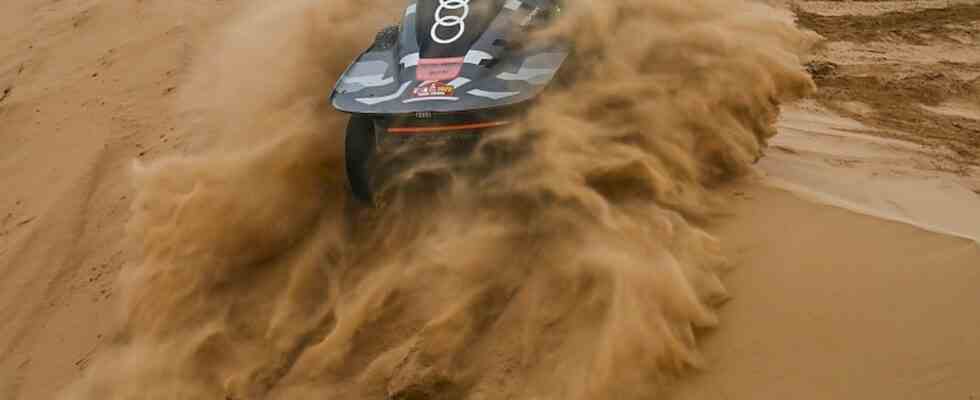Report: Interim results of the 2023 Dakar Rally
Missed chance of victory
Dakar Rally 2023
© press-inform – the press office
The 16-day Dakar Rally is halfway through. Audi’s dreams of victory have long been buried, while Toyota is heading towards a new success.
“We want to finish in the top three in the overall standings,” said Head of Audi Sport Rolf Michel before the start of the desert rally through Saudi Arabia. Because the pressure of expectations was high: Many were hoping for a victory for the Ingolstadt-based company with their electrically powered RS Q e-tron. And if it shouldn’t be enough for first place, then at least a close head-to-head race with top dog Toyota would be the minimum. In the meantime, the team can only dream of the minimum target they set for themselves: the podium: the fleet of originally three vehicles has shrunk to two. And these two are trailing behind the leaders by seven and 29 hours, respectively. As a result, Michel issues a new motto: “We still want to win as many special stages as possible and gain experience for next year.”
When the Audi RS Q e-tron made its debut last year, its revolutionary technology was new territory. The car is powered by two high-torque electric motors. They draw their power from special batteries that are charged by an ultra-compact high-performance combustion engine on the go. The concept is unique in motorsport and has no role models. The worries at the debut in 2022 were all the greater. But the Audi did well. Four stage wins and ninth place overall raised expectations for 2023 to a level that many had already dreamed of winning in 2023. The problems of the debut year, above all the excessive vehicle weight, seemed to have been resolved – especially since many competitors also attested to the high performance of the RS Q e-tron. Some people forgot that the stage victories were mainly achieved when the rally was already decided and the top drivers were no longer taking any unnecessary risks.
So far this year the balance sheet has been meager. Audi works driver Mattias Ekström won the prologue without a classification and Carlos Sainz the first stage. But that’s about it. As quickly as the vehicles started the rally, they were hit hard afterwards. There was a series of tire damage. Others were also affected by this, just not Toyota, the main opponent. The adverse weather with its heavy rainfall had washed away the sand in places, leaving only sharp stones. Additional penalties accumulated with typical rally errors, such as missing waypoints or exceeding the speed limit.
The dreams of overall victory can be buried at the latest since the weekend. Record winner Stephané Peterhansel and rally ace Carlos Saison had an accident on the same dune, independently of each other within seconds. Peterhansel survived the impact on the back of the dunes from a height of around 13 meters with an undamaged car, but an injured passenger, who was flown to Germany for treatment. On the other hand, Sainz and his co-driver were uninjured, but severely damaged the car. The fact that Ekström also suffered suspension damage the following day suddenly drew attention to the Audi suspension.
The tire chaos at the start of the rally and the resultant deficit also put pressure on the well-started Audi drivers: They took greater risks in order to gain time on the leaders. In fact, the tires from off-road tire specialist BF-Goodrich reveal a massive problem. They were developed a few years ago when the minimum vehicle weight was still 1,800 kilograms. According to the regulations, the Audi must weigh 2.1 tons, while the conventionally powered competition now has two tons. But the standard tires that all participants have to use have not been adjusted since then. It is obvious that they break more easily under higher loads – even for drivers who otherwise know how to handle the tires gently.
Neither Rolf Michel nor the technical project manager Benedikt Brunninger want to accept that the extremely high-torque Audi could be too fast for the Dakar Rally and thus overtax the chassis. “First you have to differentiate,” Brunninger clarifies: “Ekström’s damage stems from a stone that he threw up and hit the rear axle suspension. We’ll have to protect them better in the future, but you can never completely rule that out.” Ekström confirms: “I simply didn’t see the stone in the cloud of dust from the vehicle in front.”
The two hard serves by Peterhansel and Sainz are of a different caliber. Peterhansel took the dune at about 120 km/h – the associated road book for the co-driver was created at about 70 km/h. The subsequent impact on the plane was so violent that the pilot lost consciousness. Sainz, who followed just as quickly, is lucky or unlucky that his car hit the front at an angle. That absorbed energy. The Audi RS Q e-tron uses a lot of light but extremely inflexible carbon. “That’s right, our vehicle is pretty stiff,” Brunninger admits: “But it has to be to protect the high-voltage technology. However, it is the task of the dampers to absorb the energy.” Apparently, this did not work.
“It’s not a fundamental problem with our dampers,” analyzes Bunninger: “It’s a question of the setup. We tested a lot and simulated it on the computer, but we simply didn’t have the data and empirical values for such hard impacts.” So purposeful optimism is the order of the day: “Now we have it, at least partially,” the technician makes the best of the situation. Own, detailed data recording is prohibited at the Dakar Rally. And Audi is definitely not letting up. Especially since the unusual drive concept does not cause any problems, which was often doubted at first. “The project duration of three years will not be shaken,” says sports director Michel: “We’ll be back next year!”

